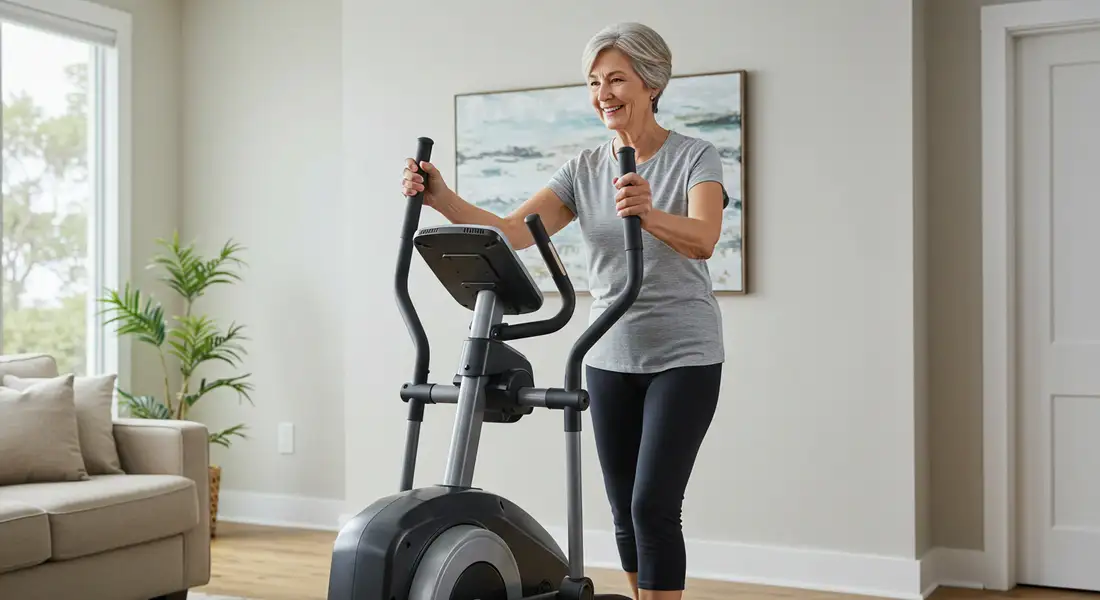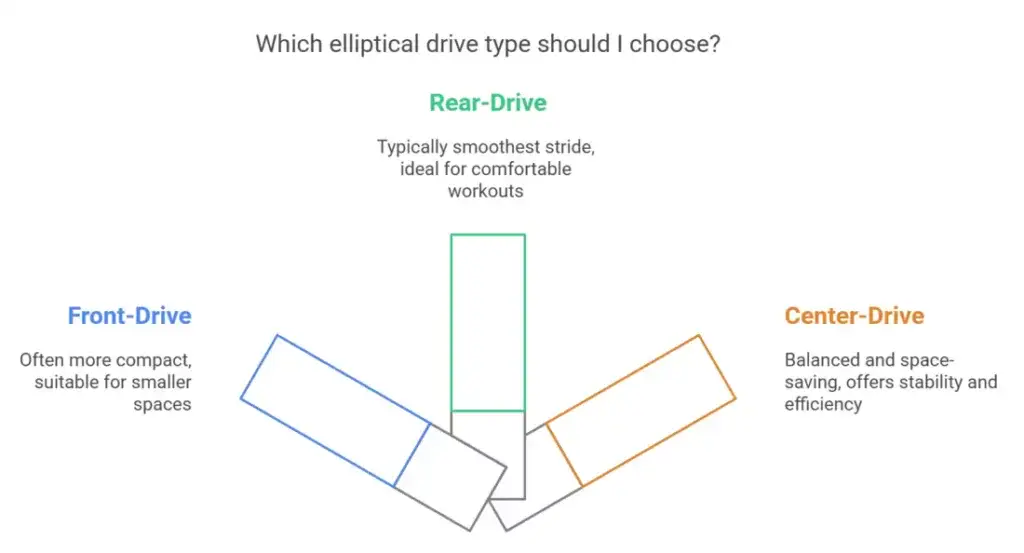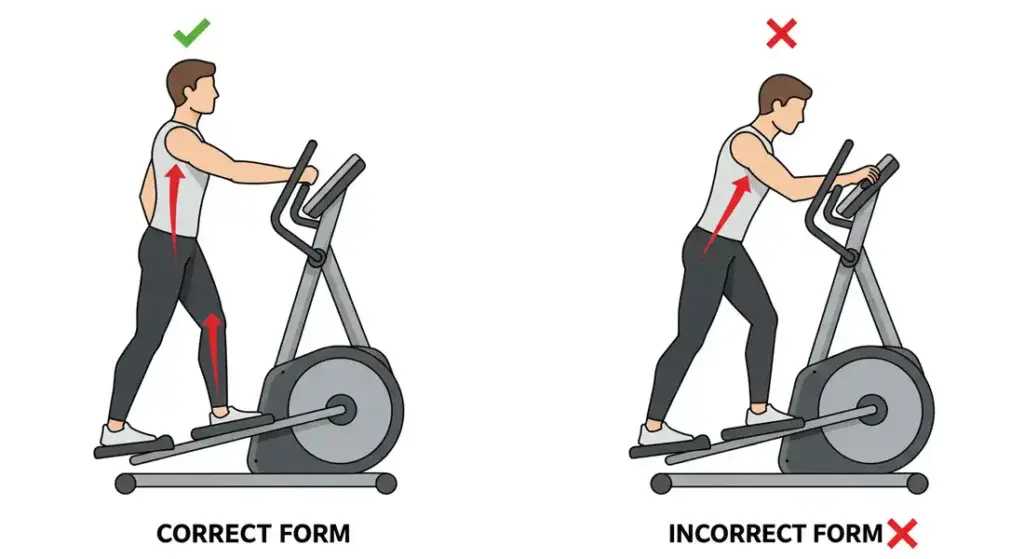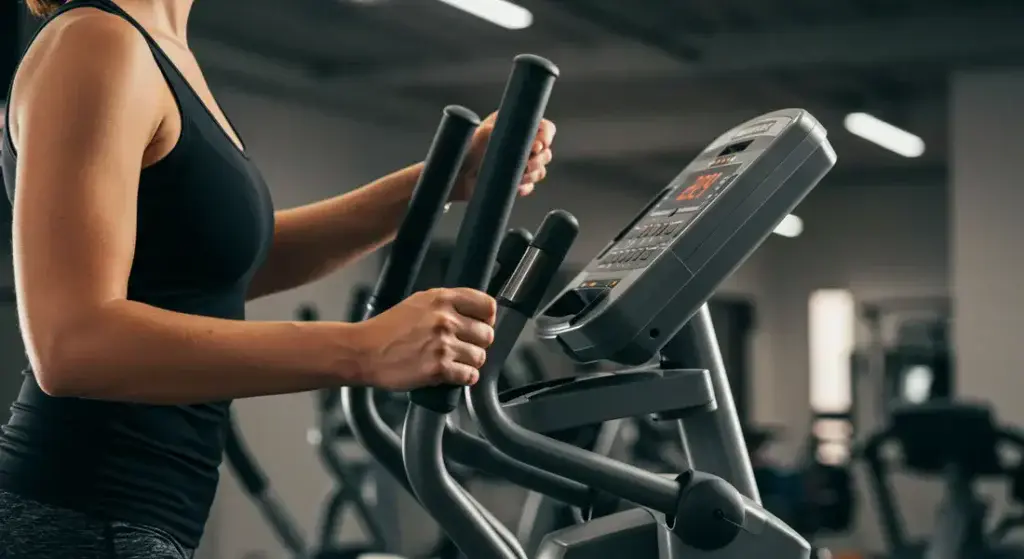Feeling the pull towards home fitness but worried about joint pain or high-impact exercises?
Maybe you’ve seen those sleek machines at the gym, the ones where people seem to glide effortlessly, and wondered if they could be your key to getting fit.
If so, you’ve come to the right place. Welcome to the Beginner’s Guide to Ellipticals, your starting point for understanding one of the most popular pieces of home cardio equipment.

Ellipticals, also known as cross-trainers, offer a unique blend of benefits that make them particularly appealing for those just starting their fitness journey or seeking a gentler way to work up a sweat.
They mimic natural movements like walking, running, and stair climbing, but with one crucial difference: your feet stay connected to the pedals, dramatically reducing the jarring impact on your knees, hips, and back.
But where do you start? Choosing the right machine, understanding the features, and knowing how to use it correctly can feel overwhelming.
Don’t worry! This guide is designed to break it all down, acting as your central hub for navigating the world of ellipticals.
We’ll touch on the core benefits, explore the different types available, highlight key features to look for, discuss proper form, suggest beginner-friendly workouts, and even compare ellipticals to other popular machines.
Think of this page as your launchpad. We’ll give you the essential overview, and then point you directly to more detailed guides on each specific topic.
Ready to glide your way to better fitness? Let’s begin.
Why Choose an Elliptical? More Than Just Low Impact
The number one reason many beginners gravitate towards ellipticals is their remarkably low-impact nature.
If the thought of running makes your knees ache, or if you’re carrying a few extra pounds and want to protect your joints, the elliptical is a fantastic ally.
This gentler approach allows for longer, more comfortable workouts, which is key for building consistency when you’re starting out.
But the benefits don’t stop there. Many ellipticals feature moving handlebars, transforming your workout into a potential full-body experience.
By actively pushing and pulling these handles, you engage your arms, shoulders, chest, and back simultaneously with your legs and glutes.
This means more muscles worked in the same amount of time, potentially leading to greater calorie expenditure and improved overall conditioning compared to lower-body-only exercises.
Want a deeper dive into all the reasons an elliptical might be perfect for you, from cardiovascular health to bone density benefits?
➡️ Explore the Detailed Benefits: [Why Choose an Elliptical? (Low Impact Benefits)](internal link to child page)
Decoding the Machine – Types of Ellipticals Explained
Walking into a store or browsing online, you’ll quickly notice that not all ellipticals look the same.
They primarily differ based on the location of the “drive system” or flywheel:
- Front-Drive: Flywheel at the front. Often feels a bit like a stair climber. Can be more compact and budget-friendly.
- Rear-Drive: Flywheel at the back. Typically offers a smoother, flatter motion closer to natural running or walking. Often longer and potentially pricier.
- Center-Drive: Flywheel often on the sides, placing you more centrally. Usually very stable and compact, offering a balanced feel.

The type of drive system affects the machine’s footprint (how much space it takes up), the feel of the stride, and often the price.
There’s no single “best” type; it depends on your preferences, budget, and available space.
Understanding these distinctions is the first step in narrowing down your options. Ready to compare them head-to-head?
➡️ Learn Which Type Suits You: [Types of Ellipticals (Front-Drive, Center-Drive, Rear-Drive)](internal link to child page)
Features That Matter for Beginners (Don’t Get Overwhelmed!)
Once you know the type, it’s time to look at features. It’s easy to get dazzled by fancy consoles and endless program options, but for a beginner, focusing on the fundamentals is key.
Here are the absolute must-knows:
- Stride Length: This is arguably the most critical feature for comfort. It’s the distance the pedals travel horizontally. Too short, and it feels choppy; too long, and you might overextend. Getting this right makes a huge difference.
- Resistance: This is how you adjust the workout intensity. Look for smooth transitions between levels and enough range to challenge you as you get fitter. Most modern ellipticals use quiet magnetic resistance.
- Console: At a minimum, you need a clear display showing your time, distance, speed (or RPM), and estimated calories burned. Heart rate monitoring is also very useful. Don’t worry too much about countless built-in programs initially.
Of course, there are other factors like flywheel weight (heavier often means smoother), incline options (for added challenge), and build quality.
But nailing stride length, resistance, and a usable console will set you up for success.
Want the full breakdown of essential vs. nice-to-have features?
➡️ Focus on What Counts: [Important Elliptical Features for New Users](internal link to child page)
Mastering the Movement – Proper Elliptical Form
Okay, you’ve chosen your machine (or you’re about to!). Now, how do you actually use it effectively and safely?
Hopping on and just moving might feel intuitive, but proper form maximizes results and minimizes injury risk.
Key things to focus on include:
- Posture: Stand tall, shoulders back, core engaged. Avoid slouching or leaning heavily on the handlebars.
- Foot Placement: Keep your feet relatively flat on the pedals; avoid rising onto your toes.
- Handlebar Use: If using moving handles, push and pull actively but smoothly. Coordinate opposite arm/leg movement.
- Smooth Motion: Aim for a fluid, controlled glide rather than jerky movements.

It might take a few sessions to feel completely natural, but focusing on these basics from the start is crucial.
Common mistakes like hunching over or letting your arms go limp are easy to fix once you’re aware of them.
Ready to learn the step-by-step technique and avoid common pitfalls?
➡️ Get it Right from Day One: [Proper Elliptical Form to Maximize Results and Avoid Injury](internal link to child page)
[Image: Side-by-side comparison: Correct vs. Incorrect elliptical posture (e.g., slouching)]
Your First Steps – Simple Elliptical Workouts for Beginners
One of the best things about ellipticals is how easy it is to get started. You don’t need complex routines initially.
Consistency is more important than intensity when forming a new habit.
Here are a couple of simple ideas:
- Steady State: Pick a comfortable resistance level and glide at a consistent pace for 15-20 minutes. You should be able to hold a conversation (the “talk test”).
- Basic Intervals: Alternate short periods (e.g., 1 minute) of slightly higher intensity (faster pace or slightly higher resistance) with longer periods (e.g., 2-3 minutes) of easier recovery pace.

Remember to always include a 5-minute warm-up at an easy pace and a 5-minute cool-down afterward.
As you get fitter, you can gradually increase the duration, resistance, or intensity of your workouts.
Need structured routines to follow?
➡️ Start Moving with Confidence: [Effective Elliptical Workouts for Beginners](internal link to child page)
Elliptical vs. The Competition – How Does it Stack Up?
A very common question beginners ask is: “Should I get an elliptical or an exercise bike?” Both are fantastic low-impact cardio options for home use, but they have key differences:
- Muscles Worked: Ellipticals generally offer more upper body and core engagement (with moving handles) alongside the lower body workout. Bikes are primarily lower-body focused.
- Impact & Motion: Both are low impact, but bikes (especially recumbent ones) might be even gentler for severe joint issues as they are non-weight-bearing. The motion is also different – gliding vs. cycling.
- Footprint: Bikes often take up less space than ellipticals.
Choosing between them often comes down to personal preference, specific fitness goals (like wanting upper body work), and any physical limitations.
Curious about the detailed pros and cons compared to an exercise bike?
➡️ Make the Right Choice for You: [Elliptical vs. Exercise Bike: A Beginner’s Comparison](internal link to child page)
[Table: Simple comparison table: Elliptical vs. Exercise Bike on key factors like Impact, Muscles Worked, Footprint]
| Feature | Elliptical | Exercise Bike (Upright/Recumbent) |
| Impact | Low (Weight-Bearing) | Low/None (Non-Weight-Bearing) |
| Muscles | Legs, Glutes, Core, Arms/Back | Legs, Glutes, (Some Core) |
| Upper Body | Yes (with moving handles) | Minimal |
| Motion | Gliding/Running Simulation | Cycling Simulation |
| Typical Size | Often Larger Footprint | Often More Compact |
| Best For | Full body, Low impact, Variety | Very Low Impact, Lower Body Focus |
Your Elliptical Journey Starts Here: Explore Our Guides
We’ve covered the essentials, but each of these topics deserves a closer look. Use the links below to dive deeper into the areas most relevant to you right now:
- ➡️ [Why Choose an Elliptical? (Low Impact Benefits)](internal link): Understand all the advantages in detail.
- ➡️ [Types of Ellipticals (Front-Drive, Center-Drive, Rear-Drive)](internal link): Compare the designs to find your fit.
- ➡️ [Important Elliptical Features for New Users](internal link): Learn exactly what specs matter for beginners.
- ➡️ [Proper Elliptical Form to Maximize Results and Avoid Injury](internal link): Master the technique for safety and effectiveness.
- ➡️ [Effective Elliptical Workouts for Beginners](internal link): Get easy-to-follow routines to start sweating.
- ➡️ [Elliptical vs. Exercise Bike: A Beginner’s Comparison](internal link): See how it stacks up against another popular choice.
You might also find our overarching [Beginners Guide to Starting Home Fitness](internal link to overarching beginner hub page) helpful for general tips on goals, space, and motivation.
Ready to Glide?
The elliptical trainer offers a fantastic path into home fitness, especially if you’re looking for an effective cardio workout that’s kind to your joints and potentially engages your whole body.
By understanding the different types, focusing on the right features, mastering proper form, and starting with sensible workouts, you can build a sustainable and enjoyable fitness routine right in your living room.
It’s not about becoming an expert overnight; it’s about taking that first step (or glide!). Use this guide and the linked resources as your companions on this journey.
What are your biggest questions about starting with an elliptical? Have you tried one before? Share your thoughts or questions in the comments below!
And if you’re ready to see some top contenders, why not [Explore Our Top-Rated Ellipticals for Beginners](internal link to relevant review category/page)?
